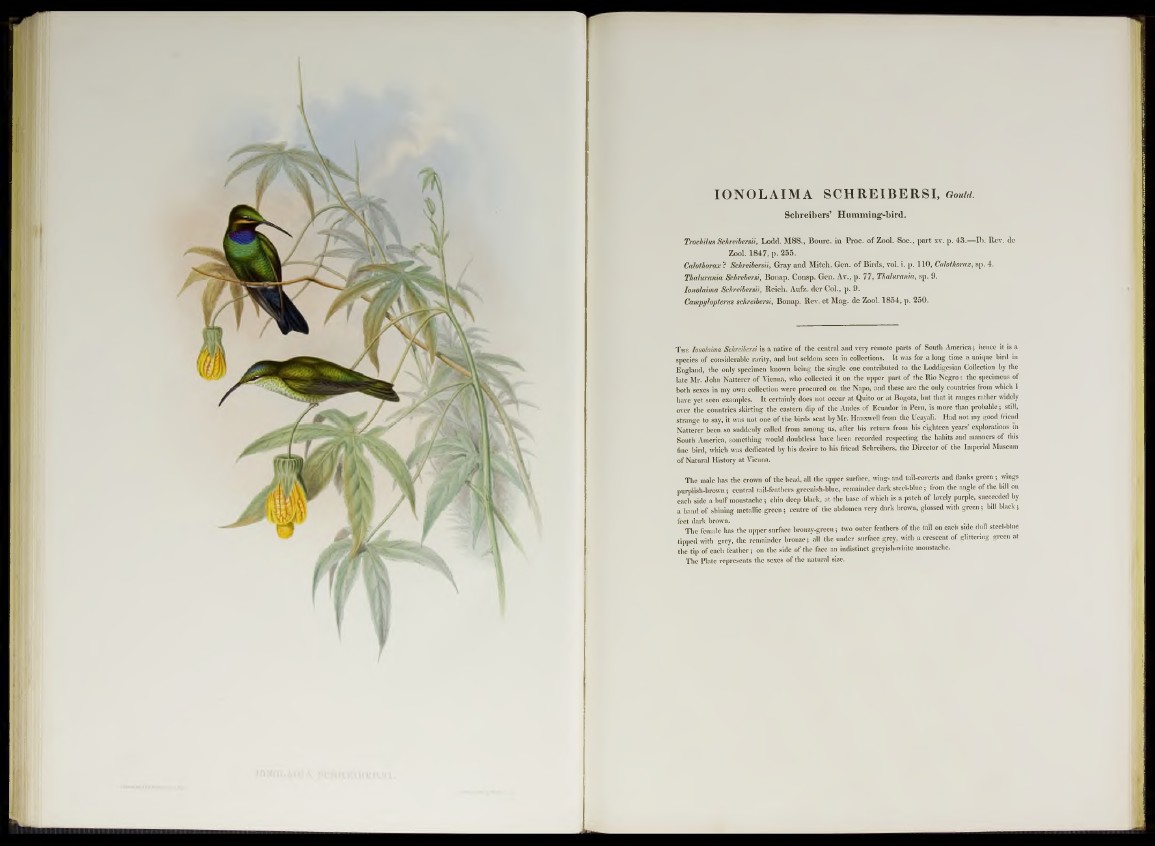
IONOLAIMA SCHREIBERSI, Gouid.
Schreibers’ Humniing-bird.
Trochilm Schreibersii, Lodd. MSS., Bourc. in Proc. of Zool. Soo., part xv. p. 43.—Ib. Rev. de
Zool. 1847, p. 255.
Calotliora.v ? Schreibersii, Gray and Miteb. Gen. of Birds, vol. i. p. 110, Calothorax, sp. 4.
Thahirania Schrebersi, Bonap. Consp. Gen. Av., p. 77, TAalurania, sp. 9.
Ionolaima Schreiberm, Keich. Aufz. der Col., p. 9.
Campylopierus schreibersi, Bonap, Rey. e t Mag. de Zool. 1854, p. 250.
T he Ionolaima Schreibersi is a native of the central and very remote parts o f South America; hence it is a
species of considerable rarity, and but seldom seen in collections. It was for a long time a unique bird in
England, the only specimen known being the single one contributed to the Loddigesian Collection by the
late Mr. John Natterer of Vienna, who collected it on the upper part of the Bio Negro: the specimens of
both sexes in my own collection were procured on the Napo, and these are the only countries from which I
have yet seen examples. It certainly does not occur at Quito or at Bogota, but that it ranges rather widely
over the countries skirting the eastem dip of the Andes of Ecuador in Peru, is more than probahle; still,
strange to say, it was not one of the birds sent hy Mr. Hauxwell from the Ucayali. Had not my good friend
Natterer been so suddenly called from among us, after his return from his eighteen years' explorations in
South America, something would doubtless have been recorded respecting the habits and manners of this
fine bird, which was dedicated by his desire to his friend Schreibers, the Director of the Imperial Museum
of Natural History at Vienna.
The male has the crown of the head, all the upper surfece, wing- and tail-coverts and flanks green ; wings
purplish-brown; central tail-feathers grecnish-blue, remainder dark steel-blue; from the angle of the bill on
each side a buff moustache; chin deep black, at the base of which is a patch of lovely purple, succeeded by
a band of shining metallic green; centre of the abdomen very dark brown, glossed with green; bill black;
feet dark brown. „
The female has the upper surface bronzy-green; two outer feathers of the tail on each side dull steel-blue
tipped with grey, the remainder bronze; all the under surfece grey, with a crescent of glittering green at
the tip of each feather; on the side of the face an indistinct greyish-white moustache.
The Plate represents the sexes of the natural size.